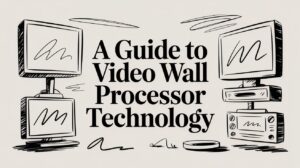
A Guide to Video Wall Processor Technology
So, what exactly is a video wall processor? Think of it as the brains of the operation for any large-scale, multi-screen setup. It’s the central

A digital signage content management system (CMS) is the software that breathes life into your network of digital screens. It’s the central command center, letting you create, schedule, manage, and push content from a single dashboard. This is what transforms a simple screen into a powerful, dynamic communication tool, saving you from the nightmare of updating each display manually.
Think of a digital signage CMS as the director of a movie. The screens are the actors, your content is the script, but it’s the director—the CMS—who tells each actor what to do, when to do it, and how to deliver their lines. Without that central direction, you’d have chaos. Or, at the very least, a whole lot of inefficient, manual work.
This software is the foundational technology that makes a modern digital signage network even possible. It's the critical difference between a basic TV playing a looping video on a USB stick and a sophisticated, multi-screen system that can adapt to changing audiences, promotions, and business goals on the fly.
At its heart, a CMS for digital signage is built to handle a few critical tasks that are absolutely essential for any successful deployment. Understanding these functions helps clarify why this software is so indispensable.
Here's a quick look at the core capabilities that every modern digital signage CMS should offer. These functions are the building blocks for creating engaging, timely, and impactful visual communications across your entire screen network.
| Function | Description | Business Impact |
|---|---|---|
| Content Management | A central library for uploading, storing, and organizing all your media files, including images, videos, web pages, and presentations. | Keeps all assets organized and easily accessible, ensuring brand consistency and saving time searching for files. |
| Playlist & Scheduling | Tools to arrange content into playlists and schedule them to play at specific times, on certain days, or in response to triggers. | Enables automated content changes, like switching from breakfast to lunch menus, or running promotions only during peak hours. |
| Remote Deployment | The ability to publish content and updates to any screen, anywhere in the world, directly from the CMS dashboard. | Eliminates the need for on-site visits with USB drives, drastically reducing labor costs and update times. |
| Network Monitoring | Real-time dashboards that show the status of every screen in your network, providing alerts for offline or malfunctioning displays. | Proactively identifies and resolves technical issues, minimizing downtime and ensuring your messages are always visible. |
These features come together to give you complete control over your messaging.
A powerful digital signage CMS enables you to manage, organize, and schedule content, helping you create and publish messages that will show up on your screens for your intended audience to see.
The explosive growth in this space reflects a major shift in how businesses communicate. The global digital signage software market is booming, with a projected value of over $27.66 billion in 2025. That number is expected to climb to nearly $41.39 billion by 2030, which just goes to show how much companies are relying on this technology to cut through the noise. You can dive deeper into digital signage software market trends at aiscreen.io.
Ultimately, a digital signage content management system is what gives you the power to deliver timely, relevant, and engaging messages with incredible efficiency and scale. It's the must-have tool for any organization serious about making a real impact with its digital displays.
So, you get the basic idea of a digital signage CMS. But where the rubber really meets the road is in its features and the way it’s built. These aren't just tech specs on a sales sheet; they're the tools that let you create communication that’s dynamic, efficient, and actually makes an impact. A great CMS takes what could be a messy technical nightmare and turns it into a simple, creative workflow.
At its heart, a user-friendly interface is non-negotiable. The best systems feel intuitive, often with drag-and-drop editors that let people without a lick of design experience build professional-looking content. This is huge. It means your marketing team can launch a new promotion on the fly without having to file a ticket with the IT department for every little change.
Beyond a simple editor, a few key features separate a basic CMS from a platform that can truly grow with you. These are the capabilities designed to tighten up your workflow, add layers of security, and make sure your content is always fresh and engaging.
This visual map breaks down how a digital signage CMS handles its three main jobs.

You can see how the system acts as a central brain, flawlessly connecting the dots between creating, scheduling, and finally deploying all of your visual content.
To really get how a digital signage CMS operates, an analogy helps. Think of the whole setup as a logistics network designed to get packages (your content) to different destinations (your screens). This network has three key players working together.
The CMS Server (The Control Tower): This is the central hub. It’s where all your content lives, playlists are built, and schedules are managed. Whether it’s in the cloud or on a server in your office, this is the brain of the entire operation, coordinating everything from one dashboard.
The Media Player (The Delivery Truck): Hooked up to each digital screen is a small piece of hardware called a media player. This little box gets its orders and content files from the CMS server, saves them locally, and does the actual work of playing the images and videos on the screen.
The Digital Screen (The Storefront): This is the final destination—the place where your audience actually sees the content. The screen is just the endpoint; it’s the media player and the CMS server that are doing all the heavy lifting behind the curtains. The quality of these displays is critical, which is why picking the right LED signs for businesses is such a foundational step in building a reliable network.
This three-part architecture—Server, Player, Screen—is the industry standard. It’s designed for reliability. Even if a media player temporarily loses its internet connection, it can keep playing the content it already downloaded. No blank screens, no downtime.
This structure is also incredibly scalable. It doesn't matter if you're managing two screens in a single shop or two thousand screens spread across the country—the basic architecture is the same. The control tower just sends more delivery trucks to more storefronts.
To really nail the design and get the most out of your system, digging into some Content Management System Best Practices can offer some great insights. It’s all about building a digital signage network that not only works for you today but is ready to handle whatever you throw at it tomorrow.
Picking the right digital signage CMS is a lot like deciding between streaming a movie or owning the physical Blu-ray. Both get you to the closing credits, but how you get there—and what it costs in terms of access, control, and money—is completely different. This choice between a cloud-based system and an on-premise one is one of the most foundational decisions you'll make for your signage network.
At its core, this is a classic trade-off: convenience versus control. A cloud-based system, often called Software-as-a-Service (SaaS), is hosted for you by the provider and you just log in through the internet. On the other hand, an on-premise solution is installed and run on your own servers, tucked safely inside your organization's network.
Cloud-based digital signage CMS platforms have become the go-to for most businesses, and it’s easy to see why. Their biggest selling point is sheer accessibility. Got an internet connection? You can log into your dashboard from anywhere—your office, your home, a coffee shop—to upload new content, tweak playlists, and check on your screens. For any business with more than one location or a remote team, this is a massive win.
The money side of things is also a huge draw. Instead of a massive upfront bill for servers and software licenses, cloud systems run on a simple subscription model. That predictable monthly or annual fee makes budgeting a breeze and drops the initial barrier to entry, which is a critical factor when you’re calculating the total outdoor LED sign cost and all the software that goes with it.
Key Takeaway: Cloud-based CMS platforms give you incredible flexibility and keep initial costs low. They’re the perfect fit for businesses that need remote management, easy scalability, and predictable operational costs without the headache of managing servers.
Plus, all the technical heavy lifting—maintenance, security patches, software updates—is handled by the provider. You don't need an in-house IT wizard to keep the servers humming. This frees up your team to focus on what actually drives results: creating amazing content for your displays.
While the cloud gets most of the attention, on-premise solutions are absolutely essential in certain situations, usually boiling down to two things: security and control. For organizations in finance, healthcare, or government, keeping data locked down within a private network isn't just a preference—it's often a strict legal or regulatory mandate. An on-premise CMS guarantees that no sensitive content ever touches the public internet.
This setup also makes you independent. If your facility has spotty internet or is in a remote location, an on-premise system doesn't care. It will keep running perfectly on your local network. You aren’t at the mercy of your internet provider or the CMS company's server status to manage your screens.
But all that control comes with some serious responsibilities.
The move to the cloud is impossible to ignore. In 2023, a whopping 42.5% of enterprises in the European Union were already using cloud services for data storage and software. This isn't a niche trend; it's a mainstream shift showing how much businesses trust the reliability and efficiency of cloud platforms. You can dive deeper into these trends over at Research Nester's digital signage market report.
To make the decision clearer, let's break down the key differences side-by-side. This table cuts through the noise and helps you see which model truly aligns with your business goals, budget, and IT capabilities.
| Factor | Cloud-Based CMS (SaaS) | On-Premise CMS |
|---|---|---|
| Initial Cost | Low. Typically a subscription fee with no hardware costs. | High. Requires purchasing servers and software licenses upfront. |
| Ongoing Costs | Predictable monthly/annual subscription fees. | Variable. Includes electricity, cooling, IT staff, and maintenance. |
| Deployment | Fast and simple. The provider handles everything. | Slow and complex. Requires internal IT team for setup. |
| Accessibility | High. Access from anywhere with an internet connection. | Limited. Typically restricted to the local network or via VPN. |
| Maintenance | None. Handled entirely by the provider. | Full responsibility. Your IT team manages all updates and security. |
| Scalability | Easy. Upgrade your plan to add more screens or features. | Difficult. Requires purchasing additional hardware. |
| Security | Managed by the provider with industry-standard protocols. | Maximum control. Data never leaves your private network. |
| Internet Dependency | High. Requires a stable internet connection for management. | Low. Operates on the local network, independent of the internet. |
Ultimately, there's no single "best" answer—only what's right for your organization. If you need ironclad security and have the IT muscle to back it up, on-premise is a formidable choice. But for the vast majority of businesses looking for flexibility, scalability, and straightforward management, a cloud-based digital signage CMS is the most practical and efficient way to go.

Let’s be honest, beautiful content is great, but it’s only half the battle. The real magic happens when you deliver the right message to the right person at the perfect time. This is where a smart approach to scheduling and content workflows separates passive screens from truly intelligent, responsive assets. A solid digital signage content management system is the engine that automates this entire process, making sure your messages are always timely and hit their mark.
Think about the journey a piece of content takes—from a simple idea in a marketing meeting to a vibrant display on a screen. A well-oiled workflow is what keeps that process from descending into chaos, preventing errors, locking in brand consistency, and letting teams work together without tripping over each other. It’s the quality control that ensures every message is polished before it ever meets a customer’s eyes.
Managing your content pipeline requires a clear, structured path. Modern digital signage CMS platforms are built specifically to guide your media through each critical stage, cutting down on friction and giving you maximum control. This isn’t just for massive global networks; it’s essential even if you’re only managing a handful of screens.
A typical content journey breaks down into four key phases:
This structured workflow is the foundation, but advanced scheduling is what really unlocks the power of your digital signage network.
Basic scheduling is simple: you play a loop of content over and over. Advanced scheduling, on the other hand, lets your screens react to the world around them. This is where a great digital signage CMS truly flexes its muscles, allowing you to automate content changes based on specific times, conditions, or even live data feeds. It transforms your displays from dumb TVs into smart communicators that feel incredibly relevant to the viewer.
Key Insight: Advanced scheduling moves beyond a fixed playlist. It creates a dynamic content strategy where screens automatically adapt to changing environments, customer behavior, and business needs without manual intervention.
For instance, a cafe can use a tactic called day-parting to automatically flip its menu boards. The screens can be set to show breakfast specials and coffee deals from 7 AM to 11 AM, then instantly switch to a lunch menu with sandwiches and salads at 11:01 AM. Later, they might pivot again to highlight happy hour specials in the evening.
Another powerful technique is conditional playback, where content is triggered by a specific event or data point. Picture a retail store with a digital screen by the entrance. Hooked up to a live weather feed, the CMS can be programmed to automatically play an ad for umbrellas the moment it starts raining outside. When the sun comes back out, the screen switches back to promoting sunglasses. This level of responsiveness makes the messaging feel personal and incredibly effective.
As you get comfortable with these workflows, you can start exploring different personalization strategies to make your signage even more powerful. By truly mastering these tools within your digital signage content management system, you guarantee every message lands with maximum impact.

As your digital signage network grows, so do the behind-the-scenes demands. The system that manages a handful of screens in one office can quickly buckle under the pressure of a hundred displays spread across the country. This is where the real test of a digital signage content management system begins, and it all comes down to three critical pillars: security, scalability, and integration.
These aren't just abstract tech concepts; they are the very foundation of a reliable and future-proof signage strategy. If you overlook them, you risk everything from embarrassing security breaches to frustrating performance bottlenecks and a system that just doesn't deliver on its promise.
In our connected world, security isn’t just a feature—it’s a necessity. Your digital signage network is a public face for your brand, and a single hacked screen displaying unauthorized content can do serious reputational damage. A secure CMS acts as your digital gatekeeper, protecting your screens from mischief and malicious attacks.
So, what should you look for? A system built with multiple layers of defense:
Security isn't just about stopping hackers. It's about maintaining absolute control over your brand's messaging, ensuring that what you plan to display is exactly what your audience sees, every single time.
Scalability is all about how well your system can grow with your business without breaking a sweat. A well-designed CMS should handle the addition of new screens seamlessly, whether you’re adding one more display in a local shop or launching a hundred new locations nationwide.
The system's architecture needs to support this growth without slowing down. This is one of the biggest advantages of a cloud-based CMS, which is inherently scalable. The provider handles all the heavy lifting with the server infrastructure, so you can add more screens simply by adjusting your plan. It’s no surprise that the services side of the signage market, including content management, is projected to grow at a CAGR of 8.2% through 2030 as businesses move away from clunky hardware and embrace flexible subscriptions. You can discover more insights about digital signage market trends to see how the industry is shifting.
Integration is what elevates a CMS from a simple content scheduler into a genuinely intelligent automation hub. By using APIs (Application Programming Interfaces) to connect your CMS to other business systems, you can create a signage network that reacts to real-world data automatically, with no human intervention needed.
Think about what this makes possible:
These kinds of integrations turn your screens from passive displays into active, data-driven tools. They streamline operations, deliver timely information, and create a far more relevant and engaging experience for your audience.
All the theory and feature lists in the world don't mean much until you see a digital signage content management system in its natural habitat. It's one thing to talk about what a CMS can do, but it's another to see how it solves real-world problems.
The beauty of a great CMS is its flexibility. The same core technology can be molded to tackle wildly different challenges across completely different industries, turning what was once a passive screen into an active, strategic business tool. Let's dig into a few examples to see what that actually looks like.
In the dog-eat-dog world of retail, a digital signage CMS is a direct line to your bottom line. Think of a clothing store. With a smart CMS, they can schedule dynamic promotions that react to the world around them. Imagine screens suddenly flashing a 25% off sale on winter coats the moment a cold front rolls in, automatically triggered by a live weather feed. That’s not just signage; it’s smart selling.
It can also solve the dreaded "out of stock" problem. A customer wants a pair of shoes in a size you don't have on the floor? Instead of a lost sale, an interactive screen lets them order it directly from the warehouse. This "endless aisle" is powered by the CMS talking directly to the store’s inventory system, turning a potential disappointment into a confirmed order.
The Problem: How do you run timely promotions that actually match the moment and avoid losing sales when inventory is low?
The CMS Fix: Automated, trigger-based content and seamless integration with inventory software.
The Payoff: More sales from hyper-relevant offers and capturing revenue you’d otherwise lose.
Inside a busy corporate office, a digital signage CMS acts like the central nervous system for internal comms. It’s the engine that powers everything from the welcoming messages for visitors in the lobby to the real-time performance dashboards firing up the sales team. It's how you get company-wide announcements out to the breakroom so everyone sees the same message at the same time.
Meeting room management is another classic pain point it solves beautifully. By integrating with the company's calendar, screens outside each conference room automatically show what’s happening, who’s in there, and when it'll be free. No more confusion, no more double-bookings. It’s a simple fix that makes the whole office feel more buttoned-up and efficient.
For hospitals and clinics, a digital signage CMS is all about improving the patient experience and cutting down on anxiety. Navigating a massive medical facility can be stressful, but large, clear screens offering easy-to-follow wayfinding can guide a nervous patient right where they need to go.
In waiting rooms, it’s a game-changer. Instead of stale magazines, screens can show a calming mix of health tips, wellness content, and light entertainment. Studies have shown this simple change can dramatically reduce how long a wait feels. Managing this constant flow of helpful information from one central dashboard helps create a calmer, more organized, and patient-first environment.
This is especially true for large facilities where clear, visible communication is non-negotiable. For anyone thinking about public-facing displays, looking into options for digital outdoor signage can offer great insights on what it takes for screens to stand up to the elements and remain highly visible.
Jumping into the world of digital signage content management systems can feel a bit like learning a new language. You've got the big picture, but the details can be fuzzy. Let's clear up some of the most common questions people have when they're getting started.
Great question. While the big, beautiful screens are the stars of the show, they can't do it all on their own. Every single display in your network needs its own dedicated media player. This is a small, powerful piece of hardware that acts as the brain for the screen.
Think of it this way: your CMS is the command center that creates the plan, but the media player is the field agent on-site. It downloads the content, stores it, and makes sure everything plays perfectly, right on cue. It’s the crucial link that brings your vision to life on the screen.
You really don't need to be an IT guru. Modern digital signage platforms are built for marketers, communicators, and business owners—not just engineers. Most feature clean dashboards and intuitive, drag-and-drop interfaces.
If you can put together a PowerPoint presentation or manage a company social media page, you've already got the skills you need. A well-designed CMS gets the technology out of the way so you can focus on what really matters: your message.
The best platforms are all about making your life easier. They empower your creativity by simplifying the workflow, so you can spend your time crafting compelling content, not fighting with confusing software.
Absolutely. In fact, this is one of the things that makes digital signage so powerful. It's not just a fancy video looper; it's a dynamic communication tool. Most modern CMS platforms make it easy to integrate live data feeds using pre-built widgets or apps.
This opens up a world of possibilities for keeping your content fresh and relevant without you having to lift a finger. You can automatically pull in and display things like:
This kind of automation ensures your screens are always engaging and providing real value to your audience, moment by moment.
Ready to see how a powerful, easy-to-use digital display system can transform your communication strategy? The experts at Smart LED Inc. are here to help you design and roll out a complete solution, from high-impact LED screens to the right management software. Explore your options and get a custom quote today at https://smartledinc.com.

So, what exactly is a video wall processor? Think of it as the brains of the operation for any large-scale, multi-screen setup. It’s the central

So, what exactly is a professional led panel for video? Think of it less like a traditional TV and more like a high-tech, luminous building

When you're looking for a massive, high-impact display, an LCD video wall is often the first technology that comes to mind. It's a proven workhorse,
"*" indicates required fields